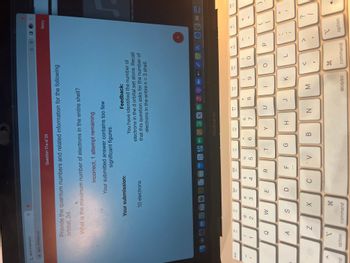Provide the quantum numbers and related information for the following orbital, 3d. What is the maximum number of electrons in the entire shell?
Provide the quantum numbers and related information for the following orbital, 3d. What is the maximum number of electrons in the entire shell?
Chemistry
10th Edition
ISBN:9781305957404
Author:Steven S. Zumdahl, Susan A. Zumdahl, Donald J. DeCoste
Publisher:Steven S. Zumdahl, Susan A. Zumdahl, Donald J. DeCoste
Chapter1: Chemical Foundations
Section: Chapter Questions
Problem 1RQ: Define and explain the differences between the following terms. a. law and theory b. theory and...
Related questions
Question
100%
![**Question: Quantum Numbers and Electron Capacity**
**Task:**
Provide the quantum numbers and related information for the following orbital, 3d.
What is the maximum number of electrons in the entire shell?
**Explanation:**
Quantum numbers describe the properties of atomic orbitals and the properties of electrons in orbitals. Here is a breakdown for the 3d orbital:
- **Principal Quantum Number (n):** 3
- This number indicates the main energy level occupied by the electron.
- **Azimuthal Quantum Number (l):** 2
- Corresponds to the d subshell (l = 0 for s, 1 for p, 2 for d, 3 for f).
- **Magnetic Quantum Number (mᵢ):** -2, -1, 0, 1, 2
- These numbers describe the orientation of the orbital in space.
- **Spin Quantum Number (s):** +1/2 or -1/2
- Indicates the two possible orientations of the electron’s spin.
**Maximum Number of Electrons:**
Each d orbital can hold a maximum of 2 electrons. Since there are 5 orbitals in the d subshell (corresponding to mᵢ values), the maximum number of electrons in a 3d subshell is:
\[ 5 \text{ orbitals} \times 2 \text{ electrons/orbital} = 10 \text{ electrons} \]
For the entire n=3 shell, including the 3s, 3p, and 3d subshells:
- 3s subshell: 1 orbital (2 electrons)
- 3p subshell: 3 orbitals (6 electrons)
- 3d subshell: 5 orbitals (10 electrons)
So the maximum number of electrons in the n=3 shell is:
\[ 2 (3s) + 6 (3p) + 10 (3d) = 18 \text{ electrons} \]](/v2/_next/image?url=https%3A%2F%2Fcontent.bartleby.com%2Fqna-images%2Fquestion%2F4bb26d64-bb49-4ec5-afc7-ea9f4d31dfb0%2Fee1eee6a-f41d-4033-affa-0242888919f2%2Fkup72qm_processed.jpeg&w=3840&q=75)
Transcribed Image Text:**Question: Quantum Numbers and Electron Capacity**
**Task:**
Provide the quantum numbers and related information for the following orbital, 3d.
What is the maximum number of electrons in the entire shell?
**Explanation:**
Quantum numbers describe the properties of atomic orbitals and the properties of electrons in orbitals. Here is a breakdown for the 3d orbital:
- **Principal Quantum Number (n):** 3
- This number indicates the main energy level occupied by the electron.
- **Azimuthal Quantum Number (l):** 2
- Corresponds to the d subshell (l = 0 for s, 1 for p, 2 for d, 3 for f).
- **Magnetic Quantum Number (mᵢ):** -2, -1, 0, 1, 2
- These numbers describe the orientation of the orbital in space.
- **Spin Quantum Number (s):** +1/2 or -1/2
- Indicates the two possible orientations of the electron’s spin.
**Maximum Number of Electrons:**
Each d orbital can hold a maximum of 2 electrons. Since there are 5 orbitals in the d subshell (corresponding to mᵢ values), the maximum number of electrons in a 3d subshell is:
\[ 5 \text{ orbitals} \times 2 \text{ electrons/orbital} = 10 \text{ electrons} \]
For the entire n=3 shell, including the 3s, 3p, and 3d subshells:
- 3s subshell: 1 orbital (2 electrons)
- 3p subshell: 3 orbitals (6 electrons)
- 3d subshell: 5 orbitals (10 electrons)
So the maximum number of electrons in the n=3 shell is:
\[ 2 (3s) + 6 (3p) + 10 (3d) = 18 \text{ electrons} \]
Expert Solution
This question has been solved!
Explore an expertly crafted, step-by-step solution for a thorough understanding of key concepts.
This is a popular solution!
Trending now
This is a popular solution!
Step by step
Solved in 2 steps with 1 images

Follow-up Questions
Read through expert solutions to related follow-up questions below.
Follow-up Question

Transcribed Image Text:**Question 17.e of 24**
*Provide the quantum numbers and related information for the following orbital, 3d.*
**What is the maximum number of electrons in the entire shell?**
- *Incorrect, 1 attempt remaining*
*Your submitted answer contains too few significant figures.*
**Your submission:**
- 10 electrons
**Feedback:**
- *You have identified the number of electrons in the d orbital set alone. Recall that this question asks for the number of electrons in the entire n = 3 shell.*
Solution
Knowledge Booster
Learn more about
Need a deep-dive on the concept behind this application? Look no further. Learn more about this topic, chemistry and related others by exploring similar questions and additional content below.Recommended textbooks for you

Chemistry
Chemistry
ISBN:
9781305957404
Author:
Steven S. Zumdahl, Susan A. Zumdahl, Donald J. DeCoste
Publisher:
Cengage Learning

Chemistry
Chemistry
ISBN:
9781259911156
Author:
Raymond Chang Dr., Jason Overby Professor
Publisher:
McGraw-Hill Education

Principles of Instrumental Analysis
Chemistry
ISBN:
9781305577213
Author:
Douglas A. Skoog, F. James Holler, Stanley R. Crouch
Publisher:
Cengage Learning

Chemistry
Chemistry
ISBN:
9781305957404
Author:
Steven S. Zumdahl, Susan A. Zumdahl, Donald J. DeCoste
Publisher:
Cengage Learning

Chemistry
Chemistry
ISBN:
9781259911156
Author:
Raymond Chang Dr., Jason Overby Professor
Publisher:
McGraw-Hill Education

Principles of Instrumental Analysis
Chemistry
ISBN:
9781305577213
Author:
Douglas A. Skoog, F. James Holler, Stanley R. Crouch
Publisher:
Cengage Learning

Organic Chemistry
Chemistry
ISBN:
9780078021558
Author:
Janice Gorzynski Smith Dr.
Publisher:
McGraw-Hill Education

Chemistry: Principles and Reactions
Chemistry
ISBN:
9781305079373
Author:
William L. Masterton, Cecile N. Hurley
Publisher:
Cengage Learning

Elementary Principles of Chemical Processes, Bind…
Chemistry
ISBN:
9781118431221
Author:
Richard M. Felder, Ronald W. Rousseau, Lisa G. Bullard
Publisher:
WILEY